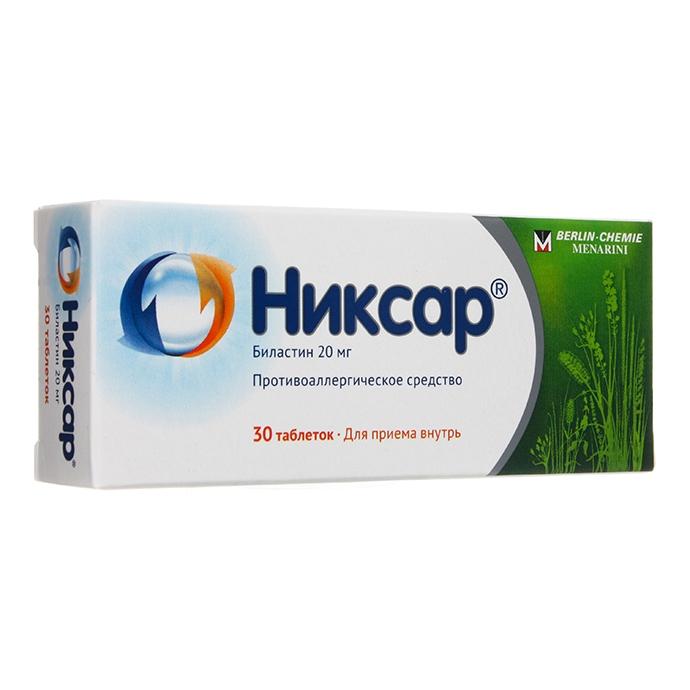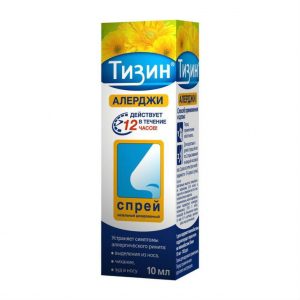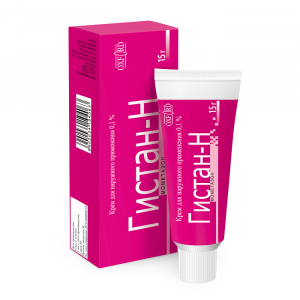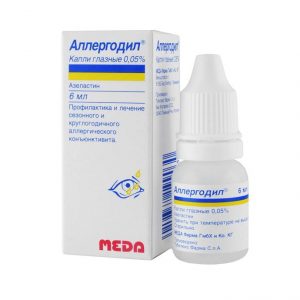Description
Pharmacological action of
antiallergic agent – H1-histamine receptors
blocker Pharmacodynamics:
Bilastine – a long-acting antihistamine, selectively blocks peripheral H1 receptors.
Significant therapeutic effect is observed one hour after taking the drug, the antihistamine effect persists for 24 hours.
Perhaps a slight penetration of bilastine through the blood-brain barrier, but bilastine does not have a significant effect on the central nervous system and does not cause a sedative effect.
Has no anticholinergic effect. Elongation of the QT interval on the ECG is not observed.
Pharmacokinetics:
Absorption. After oral administration, bilastine is rapidly absorbed from the gastrointestinal tract. The time to reach maximum plasma concentration (TCmax) is 1.3 hours. The bioavailability of bilastine when administered orally is 61%. A simultaneous meal reduces the bioavailability of bilastine by 30%. Cumulation of the drug is not observed.
Communication with plasma proteins – 84-90%.
Metabolism and excretion. Bilastine is slightly metabolized after a single application, up to 95% of the bilastine of the dose taken is excreted unchanged by the kidneys (28.3%) and with bile (66.5%). The elimination half-life (T1 / 2) is on average 14.5 hours.
In renal failure of moderate severity (glomerular filtration rate (GFR) 30-50 ml / min / 1.73 m2) and severe severity (GFR <30 ml / min / 1.73 m2) the elimination rate of bilastine slows down, which can lead to an increase in the concentration of bilastine in blood plasma. Changes in pharmacokinetic parameters do not affect the safety profile of bilastine, since the concentration of bilastine in blood plasma in patients with renal failure remains within acceptable values.
With hepatic insufficiency, clinically significant changes in the pharmacokinetic parameters of bilastine do not occur, since bilastin is slightly metabolized in the liver.
The pharmacokinetic parameters of bilastin in elderly patients are similar to those in young patients.
Indications
– Allergic (seasonal and year-round) rhinoconjunctivitis: elimination or relief of symptoms (sneezing, nasal congestion, itching of the nasal mucosa, rhinorrhea, burning sensation and itching in the eyes, redness of the eyes, lacrimation) pruritus, rash.
Contraindications
– Hypersensitivity to bilastine or auxiliary components of the drug
– age under 12 years (effectiveness and safety have not been established)
– pregnancy and the period of breastfeeding.
Use during pregnancy and lactation
The use of the drug Nixar during pregnancy is contraindicated in the absence of clinical data on the safety of use in pregnant women.
Due to the lack of data on the penetration of bilastine into breast milk, if it is necessary to use the drug Nixar during breastfeeding, it is recommended to stop breastfeeding while taking it.
Special instructions
In patients with moderate renal failure (GFR 30 ² 50 ml / min / 1.73 m2) and severe severity (GFR <30 ml / min / 1.73 m2), concomitant use with R-glycoprotein inhibitors may lead to an increase in the concentration of bilastine in blood plasma, which increases the risk of side effects.
In this regard, in patients with moderate to severe renal failure, caution should be exercised while using bilastine with P-glycoprotein inhibitors (ketoconazole, erythromycin, cyclosporine, ritonavir, diltiazem, etc.).
Impact on the ability to drive transp. Wed and fur .:
In a study conducted to assess the effect of bilastine at a dose of 20 mg on the ability to drive vehicles, the negative effect of the drug was not detected.
However, patients should be warned that in very rare cases dizziness, drowsiness may occur, which in turn may affect the ability to drive vehicles or perform other activities that require an increased concentration of attention.
When the described adverse events occur, you should refrain from performing these activities.
Composition of
Active ingredient:
bilastine – 20.00 mg
Excipients:
microcrystalline cellulose siclkrcrylcryl sodium methyl 103.00 mg A) 1.00 mg,
silicon dioxide colloidal – 0.50 mg,
magnesium stearate – 0.50 mg.
Description:
Oval, biconvex tablets of white color, with one-sided division risk.
Dosage and Administration
Inside.
Unless otherwise prescribed by a doctor, the following doses of Nixar are recommended to relieve symptoms of allergic rhinoconjunctivitis and urticaria:
Adults and children over 12 years of age: 1 tablet of the drug Nixar, which corresponds to 20 mg of bilastine, once a day.
The maximum daily dose of bilastine is 20 mg, since increasing the dose does not lead to an increase in the therapeutic effect.
A tablet is taken one hour before a meal or 2 hours after a meal (or fruit juice).
In allergic rhinoconjunctivitis, the drug is used during the entire period of contact with allergens.
With urticaria, treatment is continued until the symptoms disappear or alleviate.
Dose adjustment is not required in patients with impaired liver and kidney function.
In elderly patients, dose adjustment is not required. The experience with the use of the drug Nixar ® in persons over 65 years of age is negligible.
Side effects
Possible side effects are listed below in descending incidence: very often (? 1/10), often (? 1/100, <1/10), infrequently (? 1/1000, <1/100) , rarely (? 1/10000, <1/1000), very rarely (<1/10000), including individual messages.
Disorders of the gastrointestinal tract
Infrequently: dry oral mucosa, diarrhea, dyspepsia, gastritis, abdominal pain, pain in the upper abdomen, discomfort in the stomach, nausea.
Disorders of the skin and subcutaneous tissue
Infrequently: skin itching.
Disorders of the nervous system
Often: drowsiness, headache
Infrequently: dizziness.
Mental disorders
Infrequently: anxiety, insomnia.
Metabolic disorders
Infrequently: increased appetite, increased body weight.
Hearing disorders and labyrinth disorders
Infrequently: tinnitus, vertigo.
Disorders of the respiratory system, chest and mediastinal organs
Uncommon: shortness of breath, dryness of the nasal mucosa, discomfort in the nose.
Disorders of the cardiovascular system
Infrequently: blockade of the right bundle branch, sinus arrhythmia, lengthening of the QT interval on the electrocardiogram, other changes on the electrocardiogram.
Infectious and parasitic diseases
Infrequently: herpetic lesion of the oral cavity.
Other: Infrequently: thirst, increased fatigue, asthenia, fever, increased plasma triglycerides, increased plasma creatinine, increased activity of liver enzymes (aspartate aminotransferase, alanine aminotransferase, gamma-glutamyl transferase).
Drug interaction
With the simultaneous use of bilastine with ketoconazole or erythromycin, the area under the concentration-time curve (AUC) of bilastine increased by 2 times, and the maximum concentration (Cmax) – by 2 3 times.
With the simultaneous use of bilastine at a dose of 20 mg and diltiazem at a dose of 60 mg, the max max of bilastine increased by 50%. Similar effects can be explained by the interaction at the level of carrier proteins (including P-glycoprotein), which are responsible for the elimination of drugs from intestinal cells, the substrate of which is bilastine. With the simultaneous use of bilastine and other drugs that are substrates or inhibitors of P-glycoprotein (for example, cyclosporine), the concentration of bilastine in blood plasma may increase.
Grapefruit and other fruit juices reduce the bioavailability of bilastine by 30%. This interaction is due to the ability of fruits to suppress the activity of the protein carrier of organic anions OATP1A2, for which bilastine is a substrate. Medicines that are substrates or inhibitors of OATP1A2 (for example, ritonavir or rifampicin) can reduce the concentration of bilastine in blood plasma.
Bilastine does not enhance the action of ethanol on the central nervous system.
With the simultaneous use of bilastine and lorazepam amplification, the inhibitory effect of lorazepam on the central nervous system was not detected.
Overdose
Symptoms: when using bilastine in a dose exceeding the recommended 10-11 times, side effects occurred 2 times more often than with placebo. Most often, the following symptoms were noted: dizziness, headache, nausea. No serious side effects, including significant lengthening of the QT interval, were noted.
Treatment: symptomatic and supportive therapy. There is no specific antidote.
Storage conditions
At a temperature not exceeding 30 ° C.
Keep the drug out of the reach of children.
Expiration
5 years.
Do not use after the expiry date stated on the package.
Deystvuyuschee substances
Bylastyn
Dosage form
tablet
Appointment
Adults, Children over 12 years
Indications
Itching , Allergy, Urticaria, Allergic conjunctivitis, Allergic rhinitis
Possible product names
nixar tablets 20 mg 10 pcs.
Faes Pharma S.A., Spain




